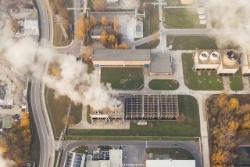Property yields unlikely to be impacted by interest rates
Property yields unlikely to be impacted by interest rates
With the Official Cash Rate (OCR) lifting 0.25% to now sit at 3%, interest rates are grabbing the attention of property investors across the country. With further rises on the horizon should investors fear a negative impact on property values? The answer, according to property consultants JLL, is not as clear cut as many would expect.
There is little doubt that recent increases in the OCR signal that the New Zealand economy is moving into an interest rate firming cycle. Many commentators are expecting the OCR to head towards 4% by the end of 2014 and potentially 5% by 2015. Notwithstanding this rise in interest rates market evidence and pricing sentiment is placing downward pressure on yields and an upward pressure on asset pricing.
Andrew Brown, Sales Investment Director at JLL says, “We are continuing to see a firming of property yields with landmark assets such as the Lumley Centre currently on the market to likely test the top end of the yield range even further.”
“If interest rates rise, conventional market wisdom would suggest that property yields will soften. Research undertaken by JLL shows however that historically this is not the case. Interest rates and property yields are both lagging economic indicators.”
Yields are a financial measure that takes into account future asset performance. Whilst there is solid economic momentum with the overall environment and limited new supply there is little to force yields back up to historical levels. This firm yield profile tends to coincide with late cycle interest rate firming.
Justin Kean, JLL Head of Research and Consulting notes, “As the market reached its peak in the last real estate cycle we saw the classic yield / interest rate relationship develop. Through June 2007, Prime yields for office and industrial firmed to a range of 7-8%. At the same time mortgage interest rates peaked at 10.8% moving very quickly in a different direction. By mid-2011 property yields were back to 9-10% and interest rates had plummeted to below 6%. Data since 1990 suggests that yields and mortgage rates actually have a negative correlation meaning that they tend to move in opposite directions rather than moving in the same direction as conventional wisdom suggests.”
The evidence provided by JLL therefore suggests that, so long as the economy has sound momentum, cap rates for property will continue to firm. As such as interest rates increase over the next two years the downward trajectory of yields will likely continue for some time.
Brown continues, “The cost of debt is only one factor investors will consider when considering direct real estate investment. Other factors include location, the strategic nature of the site not to mention the amount of debt – if any – that they are looking to secure against the asset.”
Kean continues, “ So next time you are standing round the water cooler, at a barbeque or in a high powered meeting and someone proffers the opinion that interest rates are going to impact on commercial property pricing know that like many rules of thumb in the property world, things couldn’t be further from the truth.”
– ends –


 Stats NZ: Greenhouse Gas Emissions Fall 2.0 Percent In The December 2024 Quarter
Stats NZ: Greenhouse Gas Emissions Fall 2.0 Percent In The December 2024 Quarter The Reserve Bank of New Zealand: Christian Hawkesby Appointed As Governor Of The RBNZ
The Reserve Bank of New Zealand: Christian Hawkesby Appointed As Governor Of The RBNZ Kiwi Economics: It’s Mayhem In Markets As Downside Risks Dominate Following Trump’s Tariffs
Kiwi Economics: It’s Mayhem In Markets As Downside Risks Dominate Following Trump’s Tariffs Mindful Money: Consumer Demand For Ethical Investing Remains Strong Despite International Headwinds
Mindful Money: Consumer Demand For Ethical Investing Remains Strong Despite International Headwinds Greenpeace: Taranaki - Greenpeace Activists Stop Unloading Of Palm Kernel Sourced From Indonesian Rainforests
Greenpeace: Taranaki - Greenpeace Activists Stop Unloading Of Palm Kernel Sourced From Indonesian Rainforests Seafood New Zealand: Seafood Situation Saved By A Sausage - New Plymouth Locals Innovate, Using Crayfish Bait
Seafood New Zealand: Seafood Situation Saved By A Sausage - New Plymouth Locals Innovate, Using Crayfish Bait



